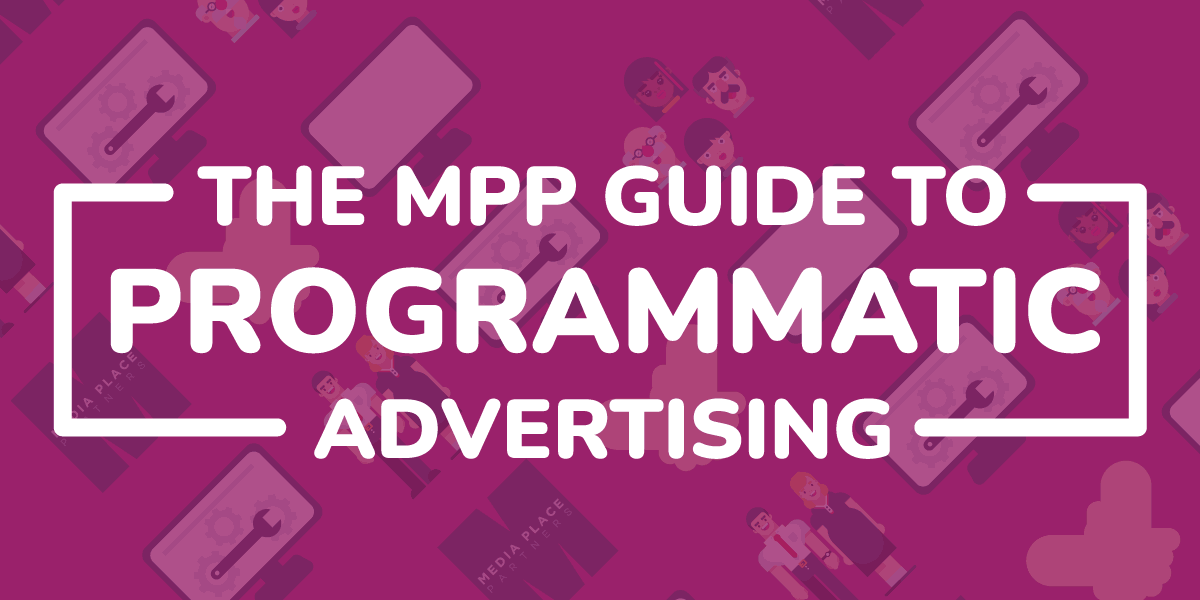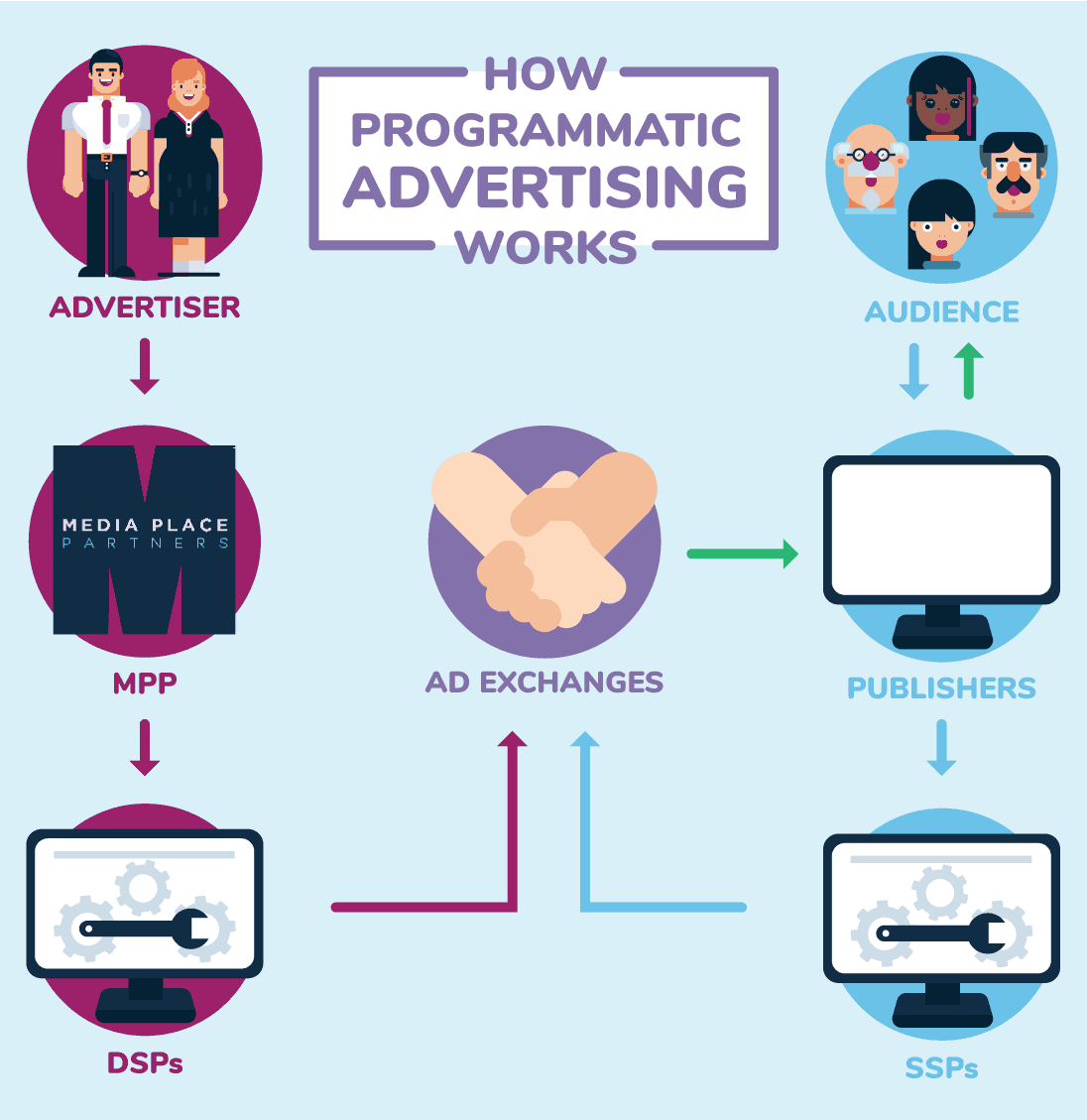
The MPP Guide to Programmatic Advertising
To understand programmatic advertising, you must first understand how advertising has traditionally worked since the beginning. This guide to programmatic advertising is designed to provide an understanding of how advertising works and how programmatic advertising in particular attempts to solve perceived shortcomings or pain points within advertising.
Advertising is the buying of time and space to gain attention and influence purchase decisions now or in the future. This is always true, no matter the channel or method. In general, most advertising methods are broken down into two main categories: traditional advertising and digital advertising. Let’s get started by learning how time and space are purchased on traditional advertising channels.
How traditional advertising buys are made
Traditional advertising relies on offline channels ( typically non-digital) to reach target audiences. Here’s a closer look at some of the mainstays of traditional advertising:
Out-of-home (OOH)
Billboards, bus ads, transit, kiosks, and the like are part of OOH advertising. OOH is advertising found outside the home, as opposed to in the home advertising through television, radio, and print.
In OOH advertising, advertisers purchase space for a specific duration at designated locations. The rates paid depend on factors like size, location, market, and traffic flow. Typically, locations can be purchased well before the flight dates for the campaign, and it is advised to book as early as possible to avoid problems with availability.
Broadcast TV and radio
Television and radio commercials continue to be popular traditional advertising methods. Advertisers buy airtime slots based on demographics, program viewership, and the time of day. Different stations in the same market can have wildly varying prices.
Advertisers should book TV and radio in advance, when possible, to avoid availability issues and to get the best pricing. With TV specifically it is important to focus on the target audience demographics and ratings more than other parameters, such as time of day. This is especially important now that viewers can watch most programs on their own schedule. Radio by contrast is best booked with combination of demographics, time of day, and ratings.
This includes items such as newspapers, magazines, brochures, and flyers. Advertisers buy space for a segment of time based on factors such as circulation numbers, the size of the ad, and placement within the publication. For instance, a front-page ad typically costs more than other placements. Most print buys are made with the publishers directly and costs can vary substantially. It’s also important to book your space as early as possible to avoid problems with availability.
For most traditional media, expect to pay up front when booking the spot. This helps the vendor manage avails effectively. Most vendors have make-good programs just in case something gets bumped or didnt run as intended. This is why you should always demand logs of what ran and when to ensure your media buy is being fulfilled. A good agency can make management of these vendors fast and easy for you.
How programmatic advertising works
On the other hand, programmatic advertising is the use of automated technology to buy and sell ad space on websites and apps. It’s an automated marketplace where advertisers compete (bid) for ad impressions, with the process relying on algorithms and real-time bidding. This automation replaces the traditional method of manual negotiations and placements between advertisers and publishers.
We’ll get there – but first, let’s go over a brief history of programmatic.
Programmatic advertising evolved from the very first banner ad in 1994. Over the next ten years, various people and companies contributed to its growth. The culmination of this was the launch of the first programmatic advertising exchange called the Right Media Exchange in 2004, a mere 4 years after Google launched AdWords.
For an excellent read on the beginning of programmatic advertising have a look at How to Succeed in Advertising (and Transform the Internet While You’re At It) from New York Magazine. Cool side note, Adtegrity is named in the article as the second company in the world to join the first programmatic advertising exchange. Why does that matter? Because Adtegrity purchased Media Place Partners back in 2017 and trades under the MPP name today. The OG staff of Adtegrity from back then still helms MPP today. So, when we say we know programmatic, we know programmatic.
Now, let’s take a closer look at the programmatic ecosystem and how programmatic works.
The programmatic advertising ecosystem
Programmatic advertising operates in a complex ecosystem with several key players, each performing critical functions. If you’re an advertiser, some of these functions are managed and operated by your internal team or your agency of record (AOR). Here are the primary key players. Note that we haven’t included everything here, instead opting to provide a more simplified version.
Demand-side platforms (DSP)
This is mission control for ad campaigns. Marketers and agencies may use DSPs to define campaign goals, budgets, targeting, and how they bid for ad impressions. DSPs connect to one or more ad exchanges. When using a DSP, you are limited to available ad inventory on the exchanges the DSP is connected to. A DSP typically earns revenue by taking a portion of your ad spend as commission to connect your campaigns with available inventory, reporting, and optimization. Options range from self-serve to fully managed services.
Supply-side platforms (SSP)
For website and app owners (publishers), an SSP can be a central hub for selling their ad inventory. The SSP manages the available ad space, connects to the ad exchanges, and through those exchanges receives placements for ads. SSPs typically earn revenue by taking a percentage of what’s earned by the publisher for running the ad. Some SSPs allow anyone to join with very little oversight, other SSPs are quite selective about the publishers they accept.
Ad Exchanges
Between the DSP and the SSP lies the ad exchange. This is where the matching of inventory, bid, and ad is done. When a user visits a website or app, the SSP requests an ad from the exchange. Data about the user and the available ad space are sent in this request. DSPs then participate in a real-time auction to win the right to place an ad. The winning ad is sent from the DSP to the exchange, then to the SSP. This all happens in milliseconds. Ad exchanges typically earn revenue by charging a percentage on any money that changes hands within the exchange.
It’s important to note that in many cases advertisers are not plugged directly into DSPs or exchanges. When working with an Agency of Record (AOR), the agency will manage the DSP and exchange relationships on behalf of the advertiser, providing the setup, management, bidding strategy, optimization, and oversight. A reputable agency is most likely plugged into multiple DSPs and exchanges to allow for greater inventory reach, flexibility, and cost management. This strategy eliminates single points of failure.
DSPs, SSPs, and Ad Exchanges are the main players in the programmatic advertising ecosystem. There are many other pieces in the ecosystem such as Data Management Platforms and Agency Trading Desks, but those are beyond the scope of this article.
The programmatic advertising process explained
Programmatic advertising at its core is quite simplistic: it is the automated buying and selling of time and space on digital advertising channels. It can become very complex when adding in different bidding strategies, data analysis, and fraud prevention, but for this article, we’ll keep it simple.

To function properly there must be two parts: the advertisements and the inventory. Advertisements come from advertisers, inventory comes from publishers. Let’s take a quick look at each:
Advertisements require several parameters and elements to be effective.
These include the target audience, a budget, formats (banners, video, social media), and any specific websites or apps they want to appear on. It’s best to place ads where your audience is, if the content isn’t offensive or damaging to your brand. Trying to make buys on specific websites or apps tends to be more expensive and limits optimization abilities.
Advertisements require several parameters and elements to be effective. These include the target audience, a budget, formats (banners, video, social media), and any specific websites or apps they want to appear on. It’s best to place ads where your audience is, if the content isn’t offensive or damaging to your brand. Trying to make buys on specific websites or apps tends to be more expensive and limits optimization abilities.
Advertisers will also consider elements including:
- Campaign goals and objectives such as brand awareness, website traffic, lead generation, sales, email signups, etc.
- Demographics including age, location, income.
- Interests and browsing behavior.
- Context of the ad based on the content of the website or app being offered.
With these key decisions made, the campaigns are set up in platforms, exchanges, with direct buys, and with DSPs.
Inventory is the time and space made available on websites and apps. The publishers of these websites and apps put their ad space up for auction across various systems, sometimes through an SSP and sometimes directly on a website or platform. Publishers detail the ad sizes, formats, and other placement details for advertisers to bid on.
Now, the magic happens.
- A user visits a website or app, and a call is made to the SSP for an ad. Data about the publisher and the user is sent to the SSP.
- The SSP then connects the request for an ad to one or more exchanges or networks. Where ad requests get sent vary by SSP and many other factors.
- Most inventory goes to exchanges who then offer the inventory in an auction to the advertisers running within the exchange. These may be direct advertisers or from a DSP.
- Advertisers bid to place an ad on that page or app. In addition to the size of the ad and the URL where the ad will run, advertisers typically know where the user is located, what kind of connection they are using, the browser they are running, as well as data that lets them know if the user recently was served one of their ads. Cookies also come into play here. For example, a user who has visited the website of the advertiser previously is more valuable than one who hasn’t, this can drive a bid higher.
- The auction starts and all bids are placed in within milliseconds. Along with the bid, different exchanges use other factors when determining which advertiser wins the auction.
- Once selected, the ad is called and then placed for the user to see. In exchange for placing the ad, the publisher who owns the space is paid by the advertiser for serving the ad.
There’s more to it of course, stacks of tech, algorithms, bidding strategies… but in general, programmatic advertising consists of an inventory source, an auction, and ads to fill the inventory. There are several benefits to using programmatic advertising instead of managing buys manually, let’s take a look.
Key benefits of programmatic advertising

Efficiency and scalability
Advertisers can reach their target audience across numerous platforms quickly and efficiently because programmatic advertising eliminates the time-consuming steps of negotiations and manual placement. When using programmatic, campaign setups tend to be faster and reach improves.
Improved targeting
With traditional methods advertisers may be limited to targeting a broad audience. Programmatic advertising allows advertisers to focus on specific demographic markers, interests, and behavior. This allows the advertiser to find not only the right audience, but oftentimes an audience that is “in-market” for their product or service. A more relevant audience increases campaign effectiveness.
Enhanced optimization
Changing traditional media channels mid-flight can be time-consuming and expensive. Innovations like digital billboards and OTT advertising for TV commercials have certainly helped, but traditional media remains a ship that takes longer to turn. By contrast, programmatic platforms constantly analyze campaign performance, allowing for adjustments to bidding, targeting, and creative assets in real or near real-time.

Data and measurement
Programmatic advertising provides rich data and analytics about each campaign. This data helps advertisers understand their audience better, identify strategies that are working (and those that aren’t) and make informed decisions for future campaigns. Advertisers can aim at various key performance indicators (KPIs) such as impressions, clicks, and conversions to help measure programmatic campaign success and return on investment (ROI). In general, traditional methods lack this sort of detailed insight.

Reduced cost
Since advertisers are competing for ad space in real-time auctions, ad spend is usually more efficient, leading to lower costs compared to traditional fixed-rate negotiations. Programmatic can also reduce overhead costs that can be associated with manual buying.
Sounds pretty great. So, as an advertiser you should spend all your dollars in programmatic. Right? In a word, no.
Traditional media plays a vital role in a holistic 360-degree campaign. Traditional components shine for top of the funnel efforts, deliver big on brand building, and provide a first-time exposure for many potential clients. We’ve all seen a billboard or heard a radio ad, then followed up by searching for that brand or product. The data captured once a search or website visit happens feeds the programmatic machine and makes it even more accurate. Never count out traditional media, because a good media plan addresses the entire customer journey, not just the sale.
For all its benefits, programmatic isn’t perfect, however.
Drawbacks of programmatic advertising
Lack of direct control
Most programmatic placements are not about the website or app they appear on, but rather consider whether your target audience is there. This can lead to some undesirable results with where a brand appears or the content a brand is adjacent to. An advertiser’s best bet is to work with a good agency that can report on and help control where campaigns run.
Risk of fraud
If there’s money to be made, criminals are there and looking for ways to take advantage. Whether it’s made for advertising sites that load ad after ad, click farms with fraudulent clicks, or viewability problems where ads load into tiny windows that can’t be seen, unsavory characters are ready to take a bite of your ad budget. Protecting your brand is an ongoing battle best left to a reputable agency with an evolving plan that changes as the criminal’s tactics change.
Complexity of setup
For those who’ve never been in the backend of a programmatic platform, consider yourselves lucky. They tend to be very complex, and a rudimentary mistake can cost thousands of dollars. What’s more, you probably need to know and be proficient in several of these platforms to fully maximize the results of your campaign. Solutions are to hire people in-house with the necessary expertise or work with an agency that has an army of people who live in these platforms day in and day out.
The future of programmatic advertising
Programmatic advertising is constantly evolving with new trends emerging to address challenges and leverage opportunities. As of this writing, there are some of the most prominent trends to watch in the coming months and years:
Programmatic digital out-of-home (PDOOH)
Digital Out of Home (DOOH) has been around for several years. You’ve most likely experienced DOOH through digital billboards that change advertisers every 30 seconds or so. For the most part, advertisers buy these spaces by working with the outdoor vendors that own the boards directly. What pDOOH hopes to accomplish is to have advertisers bid for the space in real time. The benefits of this are greater reach, flexibility, and accessibility for advertisers. The potential drawbacks include increased prices and the cannibalization of other sales channels. Just imagine bidding in real–time on a billboard during an election cycle when the deep pockets of SuperPACs can outbid everyone. You think you’re tired of political advertising now, just you wait.
The end of cookies
Companies like Google and Apple are forcing the advertising industry to explore alternative methods for audience targeting by disallowing 3rd party cookies. Doing so improves privacy for users but presents a unique challenge to keep advertising relevant. In our experience, people want privacy, but they don’t want random ads they have zero interest in. As they say, modern problems require modern solutions. Expect to see a rise in targeting methods like contextual targeting and identity solutions like Unified ID to attempt to strike a balance between privacy and ad relevance.
AI takes the wheel
Artificial Intelligence (AI) is already playing a significant role in programmatic advertising, expect a more pronounced role as capabilities and integrations improve. From smarter bidding strategies and campaign optimization in real-time to the potential for personalized ads created in real-time on the fly, the presence of AI will not be denied.
Programmatic beyond display ads
Our article focuses mostly on ads on websites and apps because that’s where the bulk of the market is today. However, we expect to see programmatic moving into other channels such as:
- Connected TV (OTT and CTV) – Cord cutting continues and CTV viewership is booming. Programmatic on OTT and CTV allows advertisers to target specific audiences on streaming platforms and smart TVs, bidding it real-time to show their commercial based on deep data in addition to context, content, and time.
- In-app advertising – Bidding for placements in real-time in mobile apps grows every year. As more apps come online with programmatic, the already vast ecosystem grows and opens doors for more targeted and efficient advertising.
- In-game advertising – Programmatic is even reaching into games, both casual and on console/PC. These platforms tend to have huge amounts of data about their players and that can be leveraged by advertisers to reach engaged audiences within their favorite games in a non-intrusive and immersive manner.
Key takeaways
- Advertising is the buying and selling of time and space.
- From the first banner ad in 1994, multiple people and companies contributed to what became programmatic advertising. The first programmatic advertising exchange began in the early 2000s and the author of this article was there when Adtegrity (now MPP) became the second company worldwide to join that exchange.
- There’s a large ecosystem of DSPs, SSPs, platforms, exchanges, DMPs and more that make programmatic advertising work. Advertisers and publishers alike use a combination of these providers to buy and sell advertising.
- Simply put, programmatic advertising is the automated buying (advertisers) and selling (publishers) of time and space on inventory (websites and apps). It’s fast, cost-efficient, scales easily, and offers improved targeting when compared to traditional advertising.
- There are drawbacks to programmatic advertising that include a lack of control, the risk of fraud, and the complexity of setup and management.
- The future of programmatic advertising is bright and is primarily driven by the demise of 3rd party cookies, the rise of AI, and expansion into other channels such as CTV.

If you find this article interesting or informative, please let us know by contacting us here. We’d love to talk to you more about programmatic advertising and how it might be useful to your business or organization.


